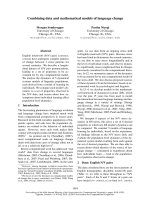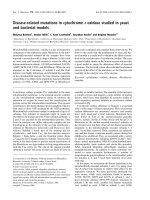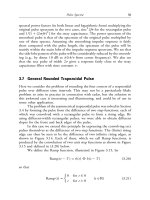SEMANTICS – ADVANCES IN THEORIES AND MATHEMATICAL MODELS ppt
Bạn đang xem bản rút gọn của tài liệu. Xem và tải ngay bản đầy đủ của tài liệu tại đây (5.33 MB, 296 trang )
SEMANTICS – ADVANCES
IN THEORIES AND
MATHEMATICAL MODELS
Edited by Muhammad Tanvir Afzal
Semantics – Advances in Theories and Mathematical Models
Edited by Muhammad Tanvir Afzal
Published by InTech
Janeza Trdine 9, 51000 Rijeka, Croatia
Copyright © 2012 InTech
All chapters are Open Access distributed under the Creative Commons Attribution 3.0
license, which allows users to download, copy and build upon published articles even for
commercial purposes, as long as the author and publisher are properly credited, which
ensures maximum dissemination and a wider impact of our publications. After this work
has been published by InTech, authors have the right to republish it, in whole or part, in
any publication of which they are the author, and to make other personal use of the
work. Any republication, referencing or personal use of the work must explicitly identify
the original source.
As for readers, this license allows users to download, copy and build upon published
chapters even for commercial purposes, as long as the author and publisher are properly
credited, which ensures maximum dissemination and a wider impact of our publications.
Notice
Statements and opinions expressed in the chapters are these of the individual contributors
and not necessarily those of the editors or publisher. No responsibility is accepted for the
accuracy of information contained in the published chapters. The publisher assumes no
responsibility for any damage or injury to persons or property arising out of the use of any
materials, instructions, methods or ideas contained in the book.
Publishing Process Manager Vedran Greblo
Technical Editor Teodora Smiljanic
Cover Designer InTech Design Team
First published April, 2012
Printed in Croatia
A free online edition of this book is available at www.intechopen.com
Additional hard copies can be obtained from
Semantics – Advances in Theories and Mathematical Models,
Edited by Muhammad Tanvir Afzal
p. cm.
ISBN 978-953-51-0535-0
Contents
Preface IX
Section 1 Background 1
Chapter 1 Let Us First Agree on what the Term “Semantics”
Means: An Unorthodox Approach to an Age-Old Debate 3
Emanuel Diamant
Chapter 2 Probabilistic Belief Logics for Uncertain Agents 17
Zining Cao
Section 2 Queries, Predicates, and Semantic Cache 43
Chapter 3 Queries and Predicate – Argument Relationship 45
Savina Raynaud
Chapter 4 Semantic Cache Reasoners 81
Muhammad Azeem Abbas, Muhammad Abdul Qadir
and Muhammad Tanvir Afzal
Section 3 Algorithms and Logic Programming 97
Chapter 5 A Common Mathematical Framework for Asymptotic
Complexity Analysis and Denotational Semantics
for Recursive Programs Based on Complexity Spaces 99
Salvador Romaguera and Oscar Valero
Chapter 6 A Semantic Framework for the Declarative
Debugging of Wrong and Missing Answers
in Declarative Constraint Programming 121
Rafael del Vado Vírseda and Fernando Pérez Morente
Section 4 Semantic Web and Interfaces 149
Chapter 7 Spatialization of the Semantic Web 151
Ashish Karmacharya, Christophe Cruz and Frank Boochs
VI Contents
Chapter 8 Representation System
for Quality Indicators by Ontology 193
Osamu Takaki, Izumi Takeuti, Koichi Takahashi,
Noriaki Izumi, Koichiro Murata and Koiti Hasida
Chapter 9 From Unstructured 3D Point Clouds
to Structured Knowledge - A Semantics Approach 213
Helmi Ben Hmida, Christophe Cruz, Frank Boochs
and Christophe Nicolle
Chapter 10 C
3
W semantic Temporal Entanglement
Modelling for Human - Machine Interfaces 247
John Ronczka
Preface
Semantics is the research area touching the diversified domains such as: Philosophy,
Information Science, Linguistics, Formal Semantics, Philosophy of Language and its
constructs, Query Processing, Semantic Web, Pragmatics, Computational Semantics,
Programming Languages, and Semantic Memory etc. The current book is a nice blend
of number of great ideas, theories, mathematical models, and practical systems in
diversified domains.
The book has been divided into two volumes. The current one is the first volume
which highlights the advances in theories and mathematical models in the domain of
Semantics. This volume has been divided into four sections and ten chapters. The
sections include: 1) Background, 2) Queries, Predicates, and Semantic Cache, 3)
Algorithms and Logic Programming, and 4) Semantic Web and Interfaces.
Section 1 presents the background and motivations for the term “Semantics”. This
section has two chapters. First chapter debates about the meaning of the Semantics
from different perspectives whereas the second chapter presents insights about
Knowledge reasoning and beliefs, subsequently, probabilistic belief logic such as:
PBL
w has been proposed and discussed.
Section 2 focuses on queries, predicates and semantic cache. This section has been
divided into two chapters. The first chapter debates on the structure of the query, the
structure of the answers, and predicate-argument relationships. Second chapter is in
the domain of semantic cache. The authors present a survey of semantic cache query
processing and semantic reasoners.
Section 3 presents two chapters from the domain of Algorithms and Logic
Programming. The first chapter presents an extended version of Schellekens technique
to provide the asymptotic upper and lower bounds of running time of a recursive
algorithm, Furthermore, the relationship between denotational semantics and
asymptotic complexity led to form a mathematical approach that model the running
time and the meaning of recursive algorithms. Second chapter presents a semantic
framework for declarative debugging of wrong and missing computed answers in
Constraint Functional-Logic Programming.
Section 4 elaborates the work in the areas of Semantic Web and Interfaces. This section
includes four chapters. First chapter discusses Spatialization of the Semantic Web to
X Preface
manage spatial data using Semantic Web framework. The framework, ArchaeoKM,
briefly conceptualizes the 4Ks such as: Knowledge Acquisition, Knowledge
Management, Knowledge Visualization and Knowledge Analysis. A case study of
industrial archaeology has been discussed in details. Second chapter presents a
representation system based on Ontology for quality indicators. Third chapter
presents a system for semantic modeling and the numerical processing to define
strategies based on domain knowledge and 3D processing knowledge. The chapter, on
one hand presents a brief introduction of semantic technologies such as: RDF, OWL,
SWRL, DL, while one the other hand, a system has been proposed, designed, and
implemented for integrating 3D processing and spatial topological components within
its framework. The last chapter presents ‘Command – Causalities – Consequences
Wisdom’ C
3
W semantics temporal entanglement modelling for human – machine
interfaces.
I would like to thank authors who participated to conclude such a nice worth-reading
book. I am also thankful to In-Tech Open access Initiative for making accessible all of
the chapters online free of cost to the scientific community.
Dr. Muhammad Tanvir Afzal
Department of Computer Science
Mohammad Ali Jinnah University, Islamabad,
Pakistan
Section 1
Background









